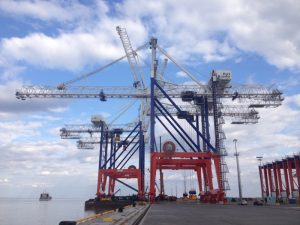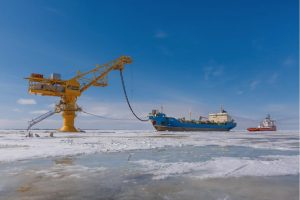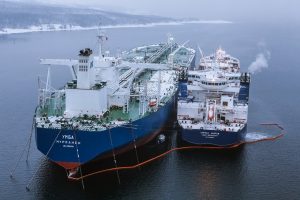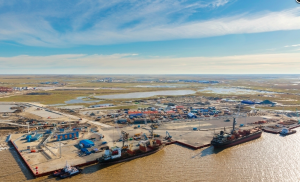The total handling capacity of the Russian sea ports has increased in 2016 by 32 mln tons, reaching 715-720 mln tons, according to the estimates of the Federal Agency Rosmorrechflot. The capacity growth was provided by the construction of new terminals as well as by the expansion of the operating ones. But the current changes in macroeconomic and geopolitical situation keep forming new trends in the development of the country’s port infrastructure.
 In the Baltics, the key event became the opening of the deep-water port of Bronka (the owner and operator Fenix LLC), 55 km west of Saint-Petersburg. The port began its operations at the end of 2015 by handling CMA CGM regular calls and in December, 2016 its Phase 2 was commissioned. Bronka offers a container terminal of 1.45 mln TEU and a ro-ro facility for 260,000 units per annum. The approach channel to Bronka port has been dredged to the depth of 14.4m. At the next stage, the container capacity of the port is planned to expand up to 1.9 mln TEU, which is expected to complete by 2020.
In the Baltics, the key event became the opening of the deep-water port of Bronka (the owner and operator Fenix LLC), 55 km west of Saint-Petersburg. The port began its operations at the end of 2015 by handling CMA CGM regular calls and in December, 2016 its Phase 2 was commissioned. Bronka offers a container terminal of 1.45 mln TEU and a ro-ro facility for 260,000 units per annum. The approach channel to Bronka port has been dredged to the depth of 14.4m. At the next stage, the container capacity of the port is planned to expand up to 1.9 mln TEU, which is expected to complete by 2020.
The Arctic Gate offshore oil terminal was launched by Gazprom Neft in May, 2016, in the Yamal  Peninsula. The terminal with a capacity of 8.5 mln tonnes per year is expected to load annually 6.3 mln tonnes of crude oil from the Novoportovskoye field, allowing the year-round dispatch of Yamal oil by tanker for onward transportation via the Northern Sea Route. The terminal is a unique facility, designed to operate in extreme natural and climatic conditions: temperatures in the region can drop below -50C, with ice as thick as 2m.
Peninsula. The terminal with a capacity of 8.5 mln tonnes per year is expected to load annually 6.3 mln tonnes of crude oil from the Novoportovskoye field, allowing the year-round dispatch of Yamal oil by tanker for onward transportation via the Northern Sea Route. The terminal is a unique facility, designed to operate in extreme natural and climatic conditions: temperatures in the region can drop below -50C, with ice as thick as 2m.
 Another Arctic oil logistics solution implemented in early 2016 by Gazprom Neft is the VLCC Umba, anchored in the Kola Bay, Murmansk region, for offshore transhipment of oil from the Novoportovskoye and Prirazlomnoye fields. Umba’s onboard infrastructure allows loading, storage and transhipment of oil, its full and timely customs and border clearance, as well as bunkering operations for shuttle-tankers and transporters. With a total cargo capacity of around 300,000 tonnes, the Umba complex can handle up to 15 mln tonnes of oil per year.
Another Arctic oil logistics solution implemented in early 2016 by Gazprom Neft is the VLCC Umba, anchored in the Kola Bay, Murmansk region, for offshore transhipment of oil from the Novoportovskoye and Prirazlomnoye fields. Umba’s onboard infrastructure allows loading, storage and transhipment of oil, its full and timely customs and border clearance, as well as bunkering operations for shuttle-tankers and transporters. With a total cargo capacity of around 300,000 tonnes, the Umba complex can handle up to 15 mln tonnes of oil per year.
 Further expansion of the port capacities in 2017 is expected to be driven by the launch of the new LNG port of Sabetta in the Yamal Peninsula. Its throughput is forecasted at 16.5 mln tons of LNG annually from the resources of the South Tambey Field, which will be shipped to Asia and Europe along the Northern Sea Route. When used for handling other types of cargo in the long term, the port’s volumes can reach 70 mln tons per year.
Further expansion of the port capacities in 2017 is expected to be driven by the launch of the new LNG port of Sabetta in the Yamal Peninsula. Its throughput is forecasted at 16.5 mln tons of LNG annually from the resources of the South Tambey Field, which will be shipped to Asia and Europe along the Northern Sea Route. When used for handling other types of cargo in the long term, the port’s volumes can reach 70 mln tons per year.
Besides, another Arctic project to start its operations in 2017 is the coal terminal in the port of Dikson, in the Chaika Peninsula, Taymyr. The first 45,000 DWT dry bulk carrier with Taymyr coal produced by Arctic Mining Company is to be dispatched from the terminal in June, 2017. In the future, annual volumes can reach 20-30 mln tons of coal. Nowadays, Arctic Mining Company managed by VostokCoal Management Company conducts exploration works at the site where high quality anthracite has been found. The company is also developing the transport infrastructure (railway and sea port) for all-year shipments along the Arctic Passage.
 However, the largest project to develop the country’s coal handling port facilities is Phase 3 of the Coal Terminal at JSC “Vostochny Port” in the Russian Far East. In 2016, a new berth of 300m length and over 16m depth was constructed to accommodate vessels of up to 180,000 DWT. The terminal is to be commissioned by the end of 2017. The extended terminal will increase the throughput of Vostochny Port up to 39 mln tons of coal per year. The Phase 3 investments amount to RUR 27 bln (USD 467 mln), including RUB 5 bln (USD 86,5 mln) for railway infrastructure facilities. No state financing is involved. The forecasted cargo base is Russian coal produced in Kuzbass and other coal fields of Russia.
However, the largest project to develop the country’s coal handling port facilities is Phase 3 of the Coal Terminal at JSC “Vostochny Port” in the Russian Far East. In 2016, a new berth of 300m length and over 16m depth was constructed to accommodate vessels of up to 180,000 DWT. The terminal is to be commissioned by the end of 2017. The extended terminal will increase the throughput of Vostochny Port up to 39 mln tons of coal per year. The Phase 3 investments amount to RUR 27 bln (USD 467 mln), including RUB 5 bln (USD 86,5 mln) for railway infrastructure facilities. No state financing is involved. The forecasted cargo base is Russian coal produced in Kuzbass and other coal fields of Russia.
Two more coal projects are to begin in 2017 in the Russian Far East. These include construction of a terminal of 15 mln tons/year in Vanino port by Far East Vanino Port Ltd and another one of 24 mln tons/year in Muchke Bay, also near Vanino, by Sakhatrans.
Looking at the above described projects, the following trends can be observed. Having recognized the potential of the Northern Sea Route in the modern economic conditions and discovered new fields of coal and gas, Russia reviewed its Arctic port infrastructure and realized its huge inconsistency with the current and future demand. The berths that have not been utilized since Soviet times, rusty cranes, shallow harbours and lack of professionals – all aspects require urgent investments and development. The recently resumed cargo transit along the Northern Sea Route marked the volume of about 7 mln tons in 2016. With the newly discovered deposits of mineral resources, this is assessed to reach 75 mln tons per year by 2025. With these figures in mind, Russia is focusing on the construction and development of dedicated deep-water northern ports.
A new impulse was given to the Far Eastern region in 2015 by declaring Vladivostok a free port. In June 2016, this regime was extended to include Vanino, Kamchatka, Chukotka and Sakhalin Island, which has triggered a few terminal projects, mostly designed to increase coal export facilities.
The container volumes fallen by 25,4% in 2015, have left Russian container terminals largely underutilized today. In 2016, the container throughput slightly recovered, having grown by 1.4%, up to 3.99 mln TEU. The 2017 volumes will obviously depend on the macroeconomic situation. With the stable ruble and real income of the population, certain stabilization in Russian container transport can be expected. At the same time, further growth of containerized exports can be forecasted. Still, the softened demand does not assume new large container projects, only modest development of the operating facilities.
